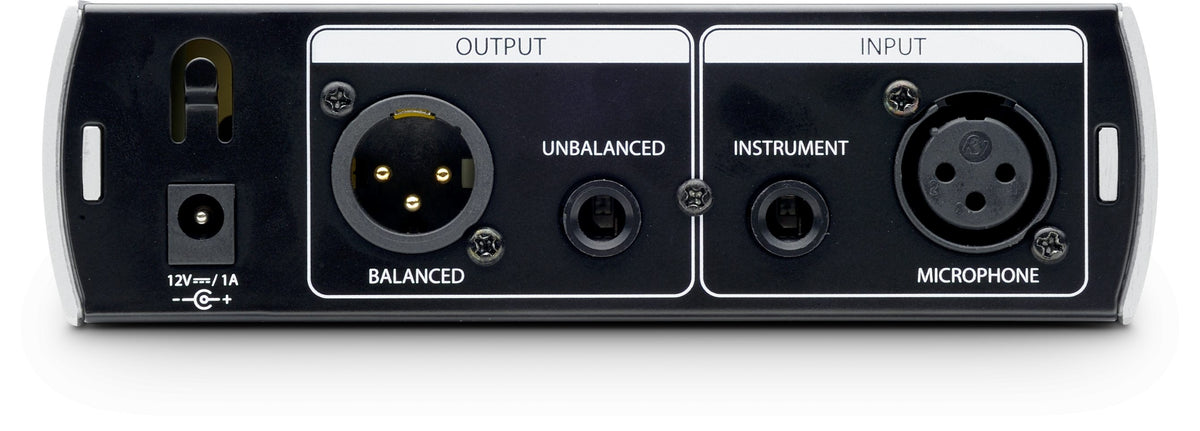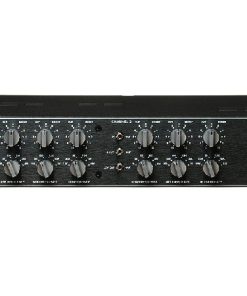Presonus TubePre V2 – Mono Tube Preamp (1/3U) PreSonus
$ 159,99 $ 64,00
Improving on a Great Sound
 At PreSonus, we’ve been designing preamps for a long time,
At PreSonus, we’ve been designing preamps for a long time,
and we always focus on audio quality first. So when we decided to upgrade our popular TubePre V2, we focused on improving an already high-quality sound—without jacking up the price. Like the original TubePre, the new version is a fully professional tube preamp, with a dual-servo (no capacitors) gain stage that lets you boost the program signal to smoking hot levels without significantly increasing the background noise. Discrete components and high-voltage operation offer dynamic range and detail not found in other single-channel tube preamps in its class.
But the TubePre V2 provides an even wider palette of sound options, and a much more focused tube saturation, than the original TubePre. It has been upgraded to employ PreSonus’ popular XMAX™ Class A solid-state preamp, which is followed in the signal path by a 12AX7 vacuum-tube stage. Twist the TubePre V2 Drive saturation control to add the “color” that only a hand-selected 12AX7 vacuum tube can deliver — from gentle warmth to total fuzz.
[EXPAND Read More About XMAX Preamps]
XMAX™ Class A Preamplifiers to Go
At PreSonus, we know that the mic preamplifier is a key component in the sonic quality of a recording. Many other companies that offer mobile recording interfaces add the cheapest possible microphone preamplifier as an afterthought. In contrast, the FireStudio Mobile includes custom-designed, high-voltage, discrete, XMAX Class A microphone preamplifiers that are suitable for use with all types of microphones.
The job of a microphone preamplifier in an audio interface is to boost a microphone-level signal to line level before conversion to the digital domain. A good preamp boosts the level to almost 400 times that of the original signal, making the preamp one of the most important stages in an interface. A cheap, off-the-shelf, op-amp-type mic preamp delivers thin, noisy, harsh results. But with XMAX preamps, the sonic quality is limited only by what microphone you plug into it.
XMAX preamplifiers are built with three key elements:
- High Voltage. The XMAX preamplifier runs on power rails of 30V. Most off-the-shelf, op-amp-based designs run on power rails of 10V to 18V. Higher-voltage power rails deliver more headroom, deeper lows, smoother highs, and a richer overall sound.
- Discrete components—not op-amps. We only use genuine transistors, resistors, and capacitors. Op-amps add noise, coloration, and harshness to a signal. Our discrete design delivers ultra-low noise and transparency.
- Class A. Class A circuits have no crossover distortion and deliver purer, clearer, and more musical results than the Class AB designs that are found in many preamps.
The net result of the XMAX preamp design is high headroom, low noise, wide dynamic range, extended frequency response, and—most important—musicality and transparency, with smooth highs, solid deep lows, and everything in between.
The 12AX7 is a miniature dual-triode vacuum tube with high voltage gain that was developed around 1946 by RCA engineers. It was first released for public sale in 1947 — and hasn’t changed design since.Part electronic fabrication, part glass-blowing, and part voodoo, tube manufacturing is nearly a lost art — only four major factories in the world still produce the 12AX7! All 12AX7 vacuum tubes are not created equal, so the tubes we use in the TubePre V2 are hand-selected and carefully tested. The tube in the TubePre V2 was hand-selected and carefully tested for electrical conformity and freedom from microphonics. (Microphonics occur when the charged elements in a vacuum tube vibrate, changing the distance between the elements. This causes charges to flows in and out of the tube, as they do in a condenser microphone, creating electrical noise and, potentially, feedback.)
Versatile and Feature-Rich
Housed in a rugged case, the TubePre V2 rear panel sports separate unbalanced, ¼” instrument and balanced, XLR mic inputs and unbalanced ¼” and balanced XLR line outputs. We’ve included all of the extras you need for professional operation including a high-pass filter, phantom power for condenser mics, polarity reverse switch, and a backlit VU meter.
The TubePre V2 is more than a mic preamp, though.
Thanks to its separate instrument and mic inputs, it also serves as a dynamite direct box (DI) for guitars and basses. And it’s small enough to carry almost anywhere, although you also can screw-mount it to a standard rack tray.
So if you are a fan of our original TubePre, you’re going to love the improved TubePre V2. And if you are checking out the TubePre for the first time, your ears are in for a real treat. Then check out the amazing low price—but sit down first because you’re in for a shock. Because with PreSonus, big sound does not have to cost big bucks.
Prompt Delivery and Professional Packaging
Our long-standing partnership with UPS FedEx DHL and other global carriers lets us offer a range of shipping services. Our warehouse staff is extremely skilled and will package your items according to our precise and exact specifications. Your goods will undergo an extensive inspection and be safely packaged prior to being sent out. Each day, we ship to thousands of customers in many countries. The fact that we are committed to becoming the biggest online retailer in the World is clear. These warehouses are in Europe in the same way as they are in USA.
Note: Orders that include more than one item are assigned a processing period depending on the item.
Before shipping, we will inspect thoroughly the items you have ordered. Most orders are shipped within 48 hours. Expected delivery time is between 3-7 days.
Returns
Stock is dynamic. It's not entirely managed by us since we are involved with multiple entities, including the factory and the storage. The actual stock can change at any moment. It is possible that your order may be out of stock once the order has been placed.
Our policy lasts for 30 days. We cannot exchange or refund your order if it has been 30 days from the date of purchase.
For your item to be returned it must be in its original packaging, unopened and in the condition you received it. The item must be in its original packaging.
Related products
500 Series
Monitor Systems
Monitor
Equalizers
Equalizers
Monitor
Monitor Systems
Recording Equipments
Headphones
Microphones
Monitor Systems
Monitor Systems
Microphones
Subwoofer
Monitor
Mic Preamp
500 Series
Recording Equipments
Recording Equipments
Recording Equipments
Subwoofer
Monitor
Accessories
Accessories








 At PreSonus, we’ve been designing preamps for a long time,
At PreSonus, we’ve been designing preamps for a long time,

























































